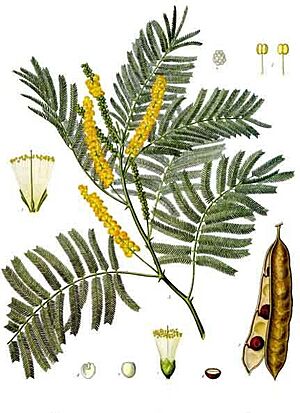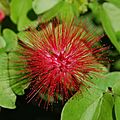Mimosoideae facts for kids
Quick facts for kids Mimosoideae |
|
|---|---|
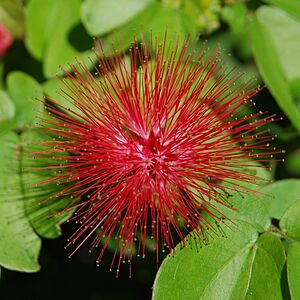 |
|
| Calliandra emarginata | |
| Scientific classification |
|
| Kingdom: | Plantae |
| Clade: | Tracheophytes |
| Clade: | Angiosperms |
| Clade: | Eudicots |
| Clade: | Rosids |
| Order: | Fabales |
| Family: | Fabaceae |
| Subfamily: | Caesalpinioideae |
| Clade: | Mimosoideae DC. |
| Informal groups | |
|
See text |
|
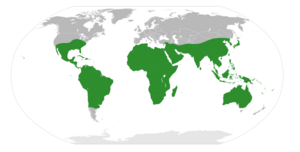 |
|
| Distribution of the Mimosoideae | |
| Synonyms | |
|
|
The Mimosoideae (say "Mim-oh-SOY-dee-ee") are a group of plants that include trees, shrubs, and vines. They are part of the larger Fabaceae family, also known as the pea or legume family. Most Mimosoideae plants grow in warm, tropical, and subtropical areas around the world.
These plants are special because of their flowers. Their flowers usually have a round shape, and their petals are folded in a specific way before they open. They also have many long, noticeable stamens (the parts that produce pollen), which often look like fluffy pom-poms.
Scientists used to classify Mimosoideae as a separate subfamily. However, newer research looking at the DNA of plants shows that Mimosoideae are actually a group inside another subfamily called Caesalpinioideae. Because of this, they are now often called the Mimosoid clade. This group includes about 40 different types of plants (genera) and around 2,500 different species.
Contents
Understanding Mimosoid Plants
Scientists use different ways to group plants together. Long ago, some systems, like the Cronquist system, treated Mimosoideae as its own family, called Mimosaceae. But today, most scientists, especially those following the Angiosperm Phylogeny Group (APG) system, consider them a part of the larger Fabaceae family.
Historically, Mimosoideae was divided into four main groups called tribes. However, modern studies using molecular phylogenetics (which looks at DNA) showed that these old groupings weren't quite right. Now, scientists have suggested new, informal groups, but they haven't been officially named as tribes yet. Also, the large group of plants known as Acacia was recently split into five smaller groups: Acacia sensu stricto, Acaciella, Mariosousa, Senegalia, and Vachellia.
What are Basal Mimosoideae?
The term "basal" in plant science often refers to groups that branched off earlier in the evolutionary tree. These groups include various genera that are considered more ancient within the Mimosoideae lineage. They are organized into several informal groups, such as:
- Adenanthera group
- Adenanthera
- Amblygonocarpus
- Calpocalyx
- Pseudoprosopis
- Tetrapleura
- Xylia
- Entada group
- Elephantorrhiza
- Entada
- Piptadeniastrum
- Newtonia group
- Fillaeopsis
- Indopiptadenia
- Lemurodendron
- Newtonia
- Prosopis group
- Neltuma
- Prosopis
- Xerocladia
- Mimozyganthus group
- Mimozyganthus
- Piptadeniopsis
- Prosopidastrum
- Leucaena group
- Desmanthus
- Kanaloa
- Leucaena
- Schleinitzia
- Dichrostachys group
- Alantsilodendron
- Calliandropsis
- Dichrostachys
- Gagnebina
- Unassigned (these don't fit neatly into the above groups yet)
- Aubrevillea
- Chidlowia
- Cylicodiscus
- Neptunia
- Pentaclethra
- Plathymenia
The Acacia Clade (Core Mimosoideae)
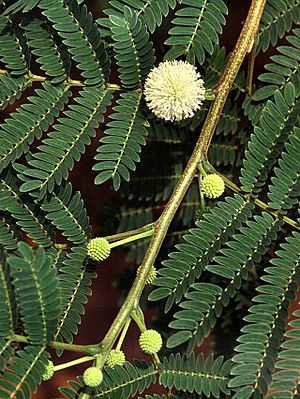
This group is considered the "core" of the Mimosoideae. It includes many well-known plants like Acacia species. Like the basal groups, it's also divided into several informal subgroups:
- Parkia group
- Anadenanthera
- Parkia
- Piptadenia group
- Adenopodia
- Microlobius
- Mimosa
- Parapiptadenia
- Piptadenia
- Pityrocarpa
- Pseudopiptadenia
- Stryphnodendron
- Abarema group
- Abarema
- Balizia
- Hydrochorea
- Ingeae grade (a group that doesn't form a single, complete branch on the evolutionary tree)
- Acaciella
- Afrocalliandra
- Albizia
- Archidendron
- Archidendropsis
- Blanchetiodendron
- Calliandra
- Cathormion
- Cedrelinga
- Chloroleucon
- Cojoba
- Enterolobium
- Faidherbia
- Falcataria
- Hesperalbizia
- Inga
- Leucochloron
- Lysiloma
- Macrosamanea
- Pararchidendron
- Pseudosamanea
- Samanea
- Sanjappa
- Serianthes
- Thailentadopsis
- Viguieranthus
- Wallaceodendron
- Zapoteca
- Zygia
- Pithecellobium group
- Ebenopsis
- Havardia
- Painteria
- Pithecellobium
- Sphinga
- Unassigned (these are still being studied to find their exact place)
- Acacia
- Mariosousa
- Paraserianthes
- Parasenegalia
- Pseudosenegalia
- Senegalia
- Vachellia
Ancient Mimosoid Plants: Fossils
Scientists have found fossilized wood from ancient Mimosoid plants. These fossils help us understand how these plants have changed over millions of years. Each name below represents a type of fossil wood that has been identified:
- †Acacioxylon
- †Adenantheroxylon
- †Albizinium
- †Albizzioxylon
- †Anadenantheroxylon
- †Cathormion
- †Dichrostachyoxylon
- †Eucacioxylon
- †Ingoxylon
- †Menendoxylon
- †Metacacioxylon
- †Microlobiusxylon
- †Mimosoxylon
- †Mimosaceoxylon
- †Paraalbizioxylon
- †Paracacioxylon
- †Piptadenioxylon
- †Prosopisinoxylon
- †Tetrapleuroxylon
The Acacieae Tribe
The Acacieae (say "Ak-uh-SEE-ee") is a group of legume plants found in tropical, subtropical, and warm-temperate regions worldwide. This group includes about 5 or 6 different types of plants and around 1,450 species.
How Acacieae Plants are Related
In 1842, a scientist named George Bentham first described the Mimosoideae subfamily. He divided it into three tribes, and Acacieae was one of them. However, in 1875, Bentham changed his definition of Acacieae to include only the Acacia group.
One main way to tell Acacieae apart from another tribe called Ingeae is by their stamens. In Acacieae, the stamens are usually separate, while in Ingeae, they are often joined together like a tube. However, some species in Acacieae do have stamens that are joined at the base. Both tribes share many features in their leaves, seeds, seed pods, and pollen.
There's one plant, Faidherbia, that scientists aren't sure where to place. It has some features of Acacieae and some of Ingeae, making it a bit of a puzzle!
What Acacieae Plants Look Like
Acacieae plants can be trees, shrubs, or vines. Some have thorns, which are actually modified parts of the plant called stipules. Others have prickles that grow from their stems.
Their leaves are often "bipinnate," meaning they are divided twice, giving them a feathery look. Some species have leaves that are modified into flat, leaf-like structures called phyllodes. Many of these plants have special glands on their leaf stalks that produce nectar, which can attract ants to protect the plant. The heartwood (the inner part of the wood) is usually red and hard, and the sap from some species can harden into a gum.
The flowers grow in dense clusters, either as round heads or spikes. The flowers usually have four or five parts and are often yellow or cream-colored, but can also be white, red, or purple. They have many stamens that stick out, making the flowers look very showy.
After flowering, these plants produce seed pods, which can vary a lot in shape and size. The seeds inside are usually flat and have a hard, dark seed coat with a special mark called a pleurogram. Some species have a colorful aril or elaiosome (a fleshy attachment) on their seeds, which can help with seed dispersal, sometimes by attracting ants.
Images for kids
See also
 In Spanish: Mimosoideae para niños
In Spanish: Mimosoideae para niños


